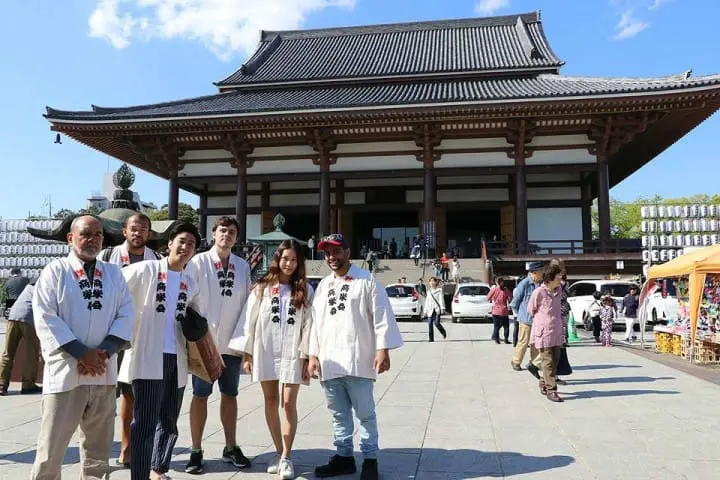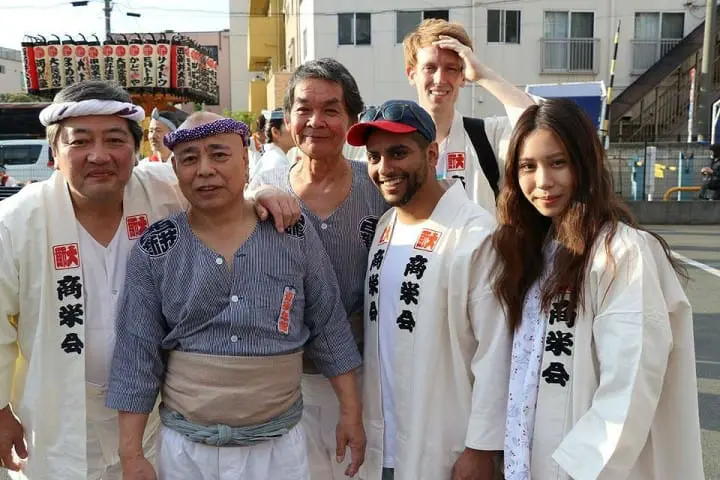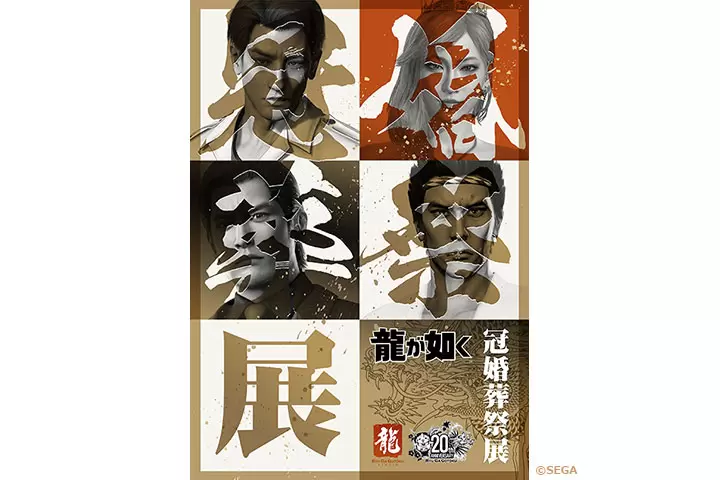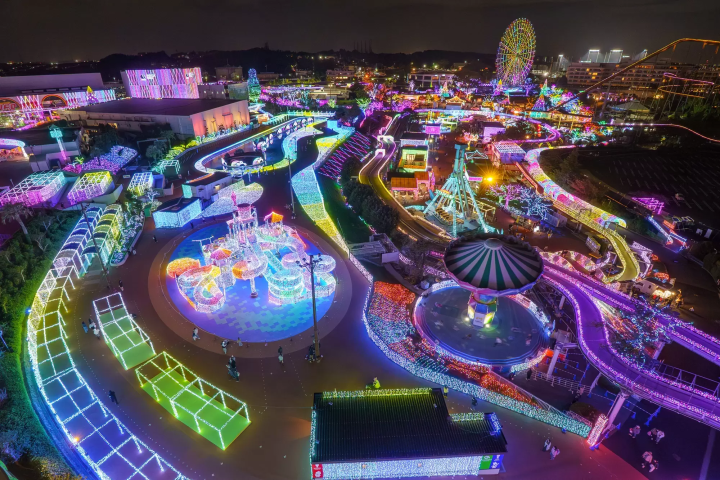Nishiarai Daishi Flower Festival - Help Carry A Portable Shrine!

Tokyo's Nishiarai Daishi Temple is known for its annual flower festival, featuring peony flowers. One of the highlights of the festival is an opportunity to help carry a portable shrine through the city streets. Today we'll give you all the details.
Located in Adachi ward's Nishiarai district, Nishiarai Daishi-Sojiji Temple is associated with Kobo Daishi (*1) and is famous for being a Yakuyoke Daishi, or a temple that wards off evil. Hence many people come here to get lucky charms for a variety of purposes, such as safe driving and for dispelling bad luck.
On the other hand, Nishiarai Daishi is also famous as a flower temple. It's on the list of the Top 100 Flower Temples in the Kanto Region, and was also chosen as Tokyo's number one fudasho (*2) of the Flower Temple pilgrimage route. On the temple grounds you can enjoy the beautiful flowers of each season, including the colorful peony flowers, for which the temple is renowned.
*1 Kobo Daishi: (774-835) was a Japanese Buddhist monk who founded the Shingon school of Buddhism, which has many followers even today. He was instrumental in helping to spread Buddhism throughout Japan. Also known as Kukai, he was given the name Kobo Daishi, posthumously.
*2 Fudasho: is a temple that both issues and receives amulets (charms to ward off evil) from visitors and pilgrims. Also, it often refers to a main temple along a pilgrimage route.

From mid April until mid May when the peony flowers are in full bloom, a flower festival is held at Nishiarai Daishi Temple.
This time, along with guests from EMBLEM Hostel Nishiarai, we have attended this flower festival at the temple. During the festival, the guests have had the chance to help carry a mikoshi, or portable shrine, an opportunity that only comes around once a year. Would you like to know what kind of reaction they had to this precious, once-in-a-lifetime experience?
The Peony Flower Garden - Highlight of the Flower Festival

On the grounds of Nishiarai Daishi Temple there's a garden filled with many types of peony flowers, such as botan (paeonia suffruticosa) and shakuyaku (paeonia lactiflora) to name just two varieties. When the flowers are at their peak, the garden's atmosphere comes alive with the sound of many visitors admiring the dazzling and delightful scenery.

These peonies (picture above) come into full bloom during the flower festival. Colorful and with a hint of elegance, they are the highlight of this annual event. Please come and have a look at these exquisite flowers, maintained meticulously, one by one, on the garden's premises.

Visitors from neighboring prefectures have also been known to make a special trip here to see these beautiful peony flowers.

In addition to the peonies, the wisteria trees are in full bloom from late April until early May. Why not go for a leisurely walk amid this fantasy-filled scenery?
You May Also Like:
See Seasonal Flowers At Tokyo's Horikiri Shōbuen Iris Garden
Dream Destination: Ashikaga Flower Park, Tochigi
Sapporo's Horomitouge Lavender Garden Is Just Too Beautiful!
Niigata's Tsunan Sunflower Field Annually Attracts 70,000 Visitors
There's Much More Than Just Flowers!

The festival also features food stalls selling local gourmet favorites, a photo contest, a mikoshi procession, a tea ceremony and many other interesting events. Please have a look at the Nishiarai Shoeikai Business Association Homepage (Japanese) for further details.
Something that we'd really like you to see is the mikoshi decorated with images of pretty peony flowers (see photo above). The festival's manto mikoshi junko, or mikoshi procession, is held only once a year during this period. The mikoshi which is usually kept in storage within the main hall of the temple, is brought out exclusively for this special occasion.
Nihonga (Japanese painting) artist Heihachi Sato, who painted the peony images on the mikoshi, has a one-man exhibition which visitors can enjoy looking at during the festival. In 2017, the exhibition was held at Nishiarai Daishi Temple's Fudomyodo from April 21st to the 23rd.

Mr. Heihachi Sato, together with his son
Though many of Mr. Sato's works of art portrait peony flowers, you can also enjoy looking at his other paintings as well. The fine and delicate techniques of nihonga (Japanese painting) that portray the beauty of nature, leave a deep impression upon the viewer.
At Nishiarai Daishi Temple, Mr. Sato's pieces are available for viewing only during the flower festival. However, if you venture out to Kita Kamakura, you can take your time and peruse his artwork at Heihachi Studio, his personal workshop. If you have plans to go to Kamakura, by all means, stop in for a visit.
Read also:
Kamakura Guide: How To Get Around, Sightseeing, Dining And more!
See Historic Kamakura: A One-Day Trip From Tokyo
Carry a Mikoshi with the Local Citizens!

Photo courtesy of Emblem Hostel Nishiarai
After the guests from Emblem Hostel Nishiarai looked around the temple grounds, they then put on a happi coat (*3). For the visitors from Australia, Mexico, America and many other countries, it was the first time for them to put on a happi coat and attend a Japanese festival. These fresh experiences will surely provide lasting memories for many years to come.
To have an opportunity to join with locals and carry a mikoshi, registration with the Nishiarai Daishi Temple Shoeikai (business association) is required. However, should you decide to stay at Emblem Hostel during the festival, staff members will gladly assist you with this registration procedure.
*3 Happi (Happi coat): a traditional straight-sleeved coat made of cotton and imprinted with a crest. It's usually worn at festivals and other special events. Open in the front, one side is overlapped over the other and tied up, similar to a kimono. This simple to put on short length coat is also worn on the job by craftspeople and tradespeople.

When the mikoshi procession first got underway, many of the visiting guests were a bit shy, but they soon overcame their hesitation and joined together with the locals to help carry the mikoshi.
The shopping street in front of the temple gates then came alive with the bustling and energetic rhythm of the festival, and the exuberant shouts and cries of mikoshi team members and onlookers.

Everyone from the hostel was encouraged by the kind instructions from the Japanese mikoshi members and also by the warm support of the local community. Before long, the visitors didn't look the least bit out of place carrying the mikoshi alongside their veteran Japanese counterparts.

Photo courtesy of Emblem Hostel Nishiarai
During the rest break, the visitors interacted with people from the local business association, and also had a chance to peek inside all the shops lining the street outside the temple. So the day's activities provided a memorable experience for everyone.
The mikoshi procession is held every year during the flower festival. For those interested in participating in this event, please contact Emblem Hostel Nishiarai or the Nishiarai Shoeikai Business Association Homepage (Japanese).
In Closing

When you join a Japanese festival, opportunities to interact with and join together with local citizens just seem to happen naturally. Of course the mikoshi procession can't take place without the cooperation of many people, both locals and visitors alike.
During Nishiarai Daishi Temple's Flower Festival, challenge yourself by joining the mikoshi team and band together with people from the local community!
Ramona, English content editor at MATCHA since 2016, has been practicing ikebana flower arrangement (Ikenobo School) and tea ceremony (Omote Senke) since 2012. She arrived in Japan in 2012 as a graduate student with a focus on Japanese literature and performing arts. As a travel editor and writer, Ramona has visited and documented 40 of Japan's prefectures with a focus on art, history, traditional Japanese crafts, and performing arts.







































![[Coupon Available] Recommended Fall/Winter Wear from Scandinavian Brand "Helly Hansen"](https://resources.matcha-jp.com/resize/720x2000/2025/12/15-252920.webp)
![Deep dive into Japanese brands! A tour of famous leather shoe stores with GENSEI & Nin [Otsuka Shoes Edition]](https://resources.matcha-jp.com/resize/720x2000/2025/12/15-252972.webp)